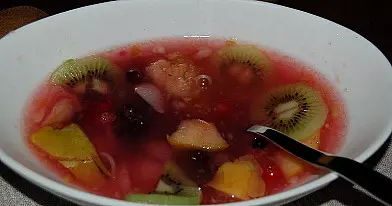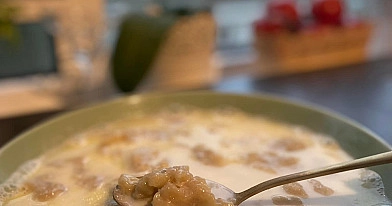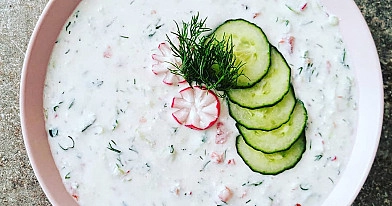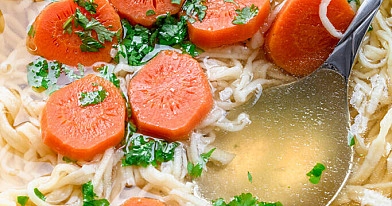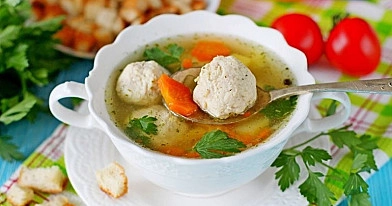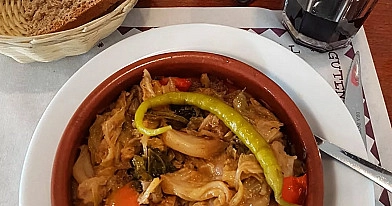
Simple hot cucumber soup with potatoes

Hot cucumber soup with potatoes is a traditional yet often overlooked comfort dish that combines the mild, refreshing flavor of cucumbers with the hearty richness of potatoes. Unlike cold cucumber soups that are usually served in summer, this version is a warm and filling meal that works beautifully for lunch or dinner during cooler months. The blend of simple ingredients creates a dish that is both humble and full of character, proving once again that old-fashioned recipes have a timeless charm.
I remember tasting this soup in my grandmother’s kitchen when she wanted to prepare something nourishing with only the vegetables available in her garden. The subtle balance between tender potatoes and the delicate cucumber flavor has stayed with me ever since. Over the years, I tested this recipe several times, experimenting with spices and textures, and the result is a trusted family dish that always feels both nostalgic and comforting.
What makes this soup stand out is the way cucumbers transform when gently simmered. Instead of being watery, they develop a soft, almost creamy texture that perfectly complements the potatoes. With the right seasoning, the soup takes on a lightly tangy and savory note, making it not only satisfying but also unique compared to more common vegetable soups.
Advertisement
Possible ingredient alternatives
- Cucumbers: Fresh cucumbers work best, but lightly pickled cucumbers can be used for a tangier variation.
- Potatoes: Any starchy variety such as Russet, Maris Piper, or Idaho potatoes is suitable. Waxy potatoes like Yukon Golds will give a creamier texture.
- Onion: Shallots or leeks can replace onion for a sweeter flavor.
- Garlic: If garlic is too strong, try substituting with roasted garlic or a pinch of garlic powder.
- Fresh dill: Parsley, chives, or tarragon can be used if dill is unavailable.
- Vegetable broth: Chicken broth can be used for extra richness. In vegan versions, miso paste mixed with water makes a good alternative.
- Cream: Heavy cream adds indulgence, but Greek yogurt or sour cream are lighter options.
Cooking tips for the soup
- Always sauté the onion before adding cucumbers and potatoes to build a deep base flavor.
- Do not overcook cucumbers, as they can lose their delicate taste; simmer gently instead.
- Add cream at the end of cooking to prevent curdling and preserve a smooth texture.
- Fresh dill should be added just before serving to keep its aroma vibrant.
- If you prefer a smooth soup, blend it before adding cream; for a rustic version, leave the vegetables in small chunks.
Chef’s advice
Cucumbers may seem like an unusual choice for hot soup, but they release a surprisingly mild and pleasant flavor when treated with care. Always peel older cucumbers to avoid bitterness, and scrape out the seeds if they are too watery. By balancing the starchy potatoes with the lighter cucumber flesh, you achieve both body and freshness in one bowl. A splash of lemon juice just before serving can also brighten the flavors significantly.
Ingredients
- Cucumbers: 2 medium (about 400 g / 14 oz).
- Potatoes: 3 medium (about 500 g / 1 lb).
- Onion: 1 medium (about 100 g / 3.5 oz).
- Garlic: 2 cloves.
- Butter or olive oil: 2 tablespoons.
- Vegetable broth: 1 liter / 4 cups.
- Fresh dill: 3 tablespoons, chopped.
- Heavy cream: 100 ml / ½ cup.
- Salt: to taste.
- Black pepper: to taste.
- Optional: a splash of lemon juice before serving.
- 1. Begin by peeling the potatoes and cutting them into even cubes so they cook at the same pace. The cucumbers should be peeled and sliced into half-moons or chunks, depending on whether you plan to blend the soup later. The onion needs to be finely chopped, and the garlic minced for a more even flavor distribution.
- 2. Place a large pot on medium heat, add the butter or olive oil, and allow it to warm. The chopped onion is added first and should be sautéed until translucent and lightly golden. This step builds the aromatic foundation of the soup.
- 3. Once the onion softens, add the minced garlic. Stir it for about 30 seconds until fragrant, being careful not to let it burn. Burnt garlic could turn the soup bitter.
- 4. The potato cubes go in next. Stir them with the onion and garlic for a few minutes so they absorb the flavors of the sautéed base. This gentle frying step enhances the earthy potato taste.
- 5. Pour in the vegetable broth, making sure all the potatoes are covered. The heat should be raised until the soup reaches a gentle boil, and then reduced to a simmer. Allow the potatoes to cook for about 15 minutes until they become tender.
- 6. Add the cucumber pieces at this stage. Let them simmer together with the potatoes for about 10 minutes. The cucumbers will soften without completely dissolving, which gives the soup its characteristic balance of texture.
- 7. Season the soup with salt and freshly ground black pepper. Taste frequently while adjusting the seasoning, since cucumbers have a delicate flavor that can be easily overshadowed.
- 8. Reduce the heat to low and stir in the heavy cream. Do not let the soup boil after cream is added, as that could affect the smoothness. The cream should be incorporated until the soup takes on a silky consistency.
- 9. Just before turning off the heat, sprinkle in the chopped fresh dill. Stir it gently, allowing the herb to release its aroma into the hot broth without losing its color.
- 10. For a final touch, squeeze in a little lemon juice if you prefer a brighter, more refreshing flavor. Serve the soup hot, optionally with crusty bread on the side.
Recipe Directions
FAQ
How can I make hot cucumber soup lactose-free or dairy-free?
To prepare this cucumber soup without dairy, replace the heavy cream with unsweetened oat cream, soy cream, or coconut cream. These alternatives provide creaminess without lactose. From my testing, oat cream keeps the soup closest to the original in both taste and consistency, while coconut cream adds a mild sweetness. For sautéing, olive oil can be used instead of butter. These substitutions maintain the smooth texture and still allow the cucumbers and potatoes to shine as the main flavors. Many professional chefs use plant-based creams in vegetable soups because their fat content stabilizes the texture without splitting, which is exactly what dairy cream provides in the classic recipe.
Can hot cucumber soup be made gluten-free?
Yes, this soup is naturally gluten-free as long as you choose a broth that does not contain wheat-based thickeners or flavorings. I always recommend checking the label of store-bought broths, since some contain hidden gluten for texture or preservation. If you want extra body without flour, you can purée part of the potatoes after simmering. This natural starch thickens the soup, a trick often used in professional kitchens to achieve a creamy consistency without adding gluten or artificial stabilizers.
Can I freeze cucumber soup and how should I reheat it?
This soup can be frozen successfully, but it is best to freeze it before adding the cream. Dairy tends to separate when thawed, leading to a grainy texture. Cook the soup up to the step before adding cream, then cool completely and portion into freezer-safe containers. It will keep for up to 3 months. When ready to serve, thaw overnight in the refrigerator and reheat gently over medium heat. Once hot, stir in fresh cream to restore its smoothness. This method is commonly recommended in professional kitchens because it preserves both the flavor and texture of cream-based soups.
What is the best way to adjust the soup if it tastes too watery?
If the soup seems too thin, the easiest solution is to let it simmer uncovered for an additional 5–10 minutes, allowing excess liquid to evaporate. Another method is blending part of the potatoes into the broth, which releases natural starch and thickens the texture. If you prefer a richer version, stirring in a spoonful of sour cream or Greek yogurt at the end adds body without overpowering the cucumber flavor. These methods work because starch molecules expand when heated, binding liquid naturally, while dairy proteins enhance creaminess. From personal cooking experience, adjusting thickness gradually yields the most balanced result without losing the delicate cucumber aroma.
What common mistakes should I avoid when making hot cucumber soup?
The most common mistake is overcooking the cucumbers, which can make them mushy and strip away their fresh flavor. They should be added only after the potatoes have softened and simmered briefly. Another mistake is boiling the soup after adding cream, as this can cause separation and ruin the silky texture. It is also important not to overseason; cucumbers have a subtle taste that can be overshadowed by too much salt or pepper. Finally, avoid using cucumbers with tough skins or large seeds without peeling and deseeding, since they can introduce bitterness. These lessons come from both traditional family practice and repeated recipe testing, where attention to timing and ingredient quality always produced the best soup.


